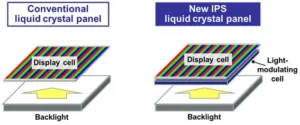
We decided to make a combined LDM/MDM issue this week as we were trying to catch up after finishing the IBC report. We didn’t think you would mind as we have produced a lot of content in September! We held a couple of stories over for next week so that we had a bit more time to work on them. Ken was also at an Automotive event this week, so there is more still to come.
One of the big stories for me has been the dual layer LCD that Panasonic is making and supplying to Eizo and Ikegami for high end mastering monitors that have 1,000,000:1 contrast and 1,000 cd/m² of output. They look very good as they can match OLEDs in black level, while having a much better performance when more than a small percentage of the display is bright white. The LG OLEDs that can supply high peak white brightness for small areas drop down to around 150 cd/m² when you have a big area. The LCDs don’t and that’s a big advantage. Unlike panels that get that level of contrast just by dimming the backlights, there are no ‘halo’ effects.
We carry a couple of related stories in this week’s main issue. First, the EBU has a new set of recommendations for broadcast reference monitors and they will cause trouble for OLED monitor makers. OLEDs will simply not be able to meet the 10,000 cd/m² requirement for PQ Grade 1A, perhaps ever (although I usually say ‘don’t bet against the engineers’ so they will probably prove me wrong!).
OLEDs might be able to meet the 1,000 cd/m² peak requirement for Grade 1 HLG monitors, but I’m not at all sure that they will be able to meet the 203 cd/m² overall screen performance when fed with just 75% of the full HLG code value. LCDs will be able to do this. We have reached out to a couple of makers to see if they think they can meet the requirement. The value of 75% is the HLG level for diffuse white in production and that is to allow around 2.5 stops of headroom for highlights. For more on this, see the article on HLG in the IBC report. (BBC Updates on HLG Status)
The other related story is that Innolux was planning to show a dual layer 50″ LCD with high contrast at the Touch Taiwan show and said that it had overcome ‘production problems’. Again, we have reached out for more information, but haven’t got anything back, yet. I suspect, however that this will not be suitable for non-professional use. The problem is that such a double layer will be very inefficient. The Eizo 32″ monitor uses a typical 260W, so a 65″ version might use a kilowatt! That would be good for heating the house, but would not be legal in the US or in Europe in the TV market.
It’s hard to see how you would make such a design and make it efficient. Cost could come down as the second panel could be simpler than the main one, although it would need its own active substrate, I guess. However, it would have to add 25% or more to the basic cost, even if there was no additional backlighting needed.
The idea is not a new one – we reported some years ago on a million to one contrast LCD shown by Sharp at CES, and the company wouldn’t say how it was doing it, but we believed at the time that it was a double modulation scheme. The same concept has been used by Christie to make extremely high contrast prototype projectors.
Anyway, as we often see, the tough competition from OLED is forcing the LCD makers to improve and as they do, the OLED makers will have to respond and, in the end, the viewers and consumers will be the winners. There really is no comparison in image quality between the best TVs of just a few years ago and the best today.
Bob

